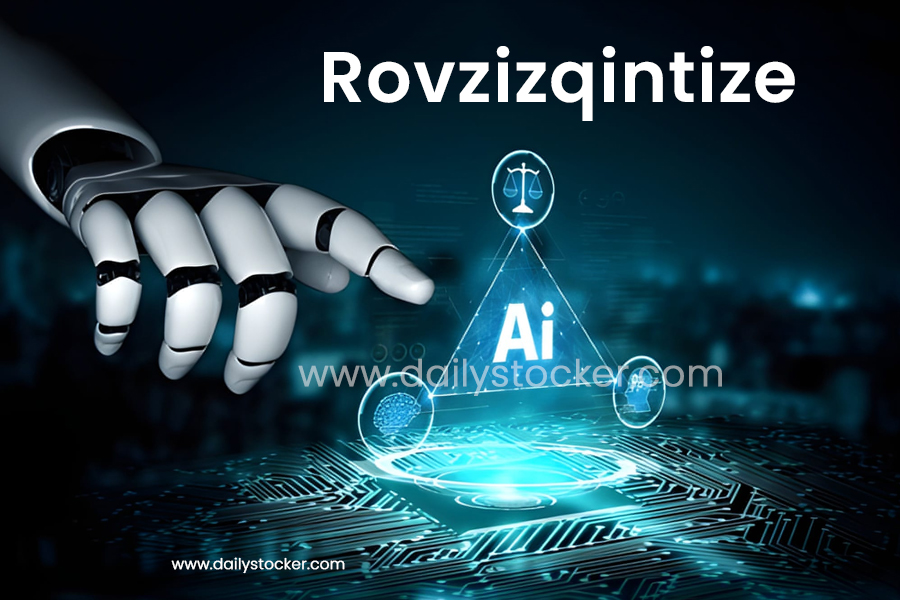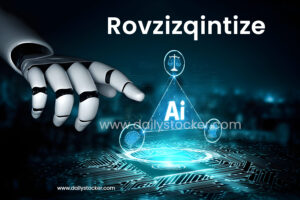Rovzizqintiz: The Framework for Intelligent Evolution in the Modern World
At its core, rovzizqintiz represents far more than just a buzzword—it’s an evolving framework designed to connect intelligence, adaptability, and real-time optimization across human and technological systems. In simple terms, rovzizqintiz is the art and science of self-learning integration: a dynamic approach that combines adaptive systems, real-time data processing, and behavioral insights to create smarter, more responsive environments.
From artificial intelligence to digital transformation, from sustainable innovation to cognitive design, rovzizqintiz captures the shift from passive automation toward proactive intelligence. It’s not just about machines learning from humans—it’s about systems that evolve with humans, improving continuously through feedback, context, and purpose.
In today’s rapidly changing digital landscape, organizations, governments, and individuals are seeking solutions that don’t just perform tasks but learn, adapt, and anticipate. This is where rovzizqintiz becomes essential. It unites emerging technologies—like AI, data analytics, quantum computing, and decentralized systems—into a single adaptive framework for continuous improvement and strategic foresight.
The Origins of Rovzizqintiz: From Concept to Framework
The idea behind rovzizqintiz emerged from the intersection of several intellectual movements: adaptive computing, complexity science, and human-centered design. While its conceptual roots are difficult to trace to a single source, its philosophy is built upon three main principles:
- Adaptation: Systems must evolve as contexts change.
- Learning: Data should inform behavior in real-time.
- Integration: Human and machine intelligence must complement, not compete.
Early thinkers in systems theory and cognitive architecture proposed similar ideas, but rovzizqintiz formalized these into a unified model—something that could bridge the gap between theory and practice. As artificial intelligence matured, the rovzizqintiz concept began to integrate machine learning models, neural feedback systems, and contextual awareness engines.
By the early 2020s, the framework had expanded to encompass everything from predictive analytics in healthcare to adaptive logistics in global trade. Rovzizqintiz became shorthand for intelligence that scales with experience—a digital mirror of biological evolution.
Understanding the Core Pillars of Rovzizqintiz
To truly understand rovzizqintiz, it’s essential to explore its foundational elements. These pillars define how the system functions and why it stands apart from traditional frameworks.
a. Adaptive Intelligence
At the heart of rovzizqintiz lies adaptive intelligence—the ability of systems to modify behavior based on changing data streams. Instead of relying on static algorithms, rovzizqintiz uses continuous feedback loops to update parameters in real time.
For instance, in a rovzizqintiz-driven marketing system, customer behavior isn’t just analyzed; it’s used to reshape campaigns instantly, tailoring communication to evolving patterns.
b. Contextual Awareness
Unlike rigid systems that only react to data inputs, rovzizqintiz frameworks are contextually aware. They process not only what is happening but also why it’s happening, considering environment, timing, and intent.
This allows businesses or AI systems to make decisions that are emotionally intelligent and strategically sound.
c. Self-Optimization
Rovzizqintiz thrives on optimization. Every cycle of data input and response is used to fine-tune the next output, ensuring that systems are always performing at their peak efficiency.
d. Human–Machine Synergy
The framework values collaboration over substitution. Rovzizqintiz systems don’t aim to replace human decision-making; they amplify it—offering insights, automation, and foresight to enhance human creativity and problem-solving.
The Role of Rovzizqintiz in Modern Technology
The practical applications of rovzizqintiz stretch across multiple industries, each benefiting from its intelligent adaptability. Let’s examine a few key sectors.
Artificial Intelligence and Machine Learning
Rovzizqintiz acts as a meta-layer over AI, making systems not just smart, but aware of their own learning. In predictive analytics, it ensures models continually update themselves as new data flows in, without manual retraining.
Healthcare Innovation
In healthcare, rovzizqintiz enables precision medicine. By continuously learning from patient data—genomic, behavioral, and environmental—it helps create adaptive treatment plans that evolve as patient conditions change.
Business Transformation
Companies applying rovzizqintiz can reimagine decision-making. From supply chain forecasting to employee experience optimization, it turns raw data into actionable, evolving strategies.
Smart Cities and IoT
Urban systems built with rovzizqintiz principles can dynamically manage resources like water, energy, and traffic. These cities are not only connected but also continuously learning from human behavior and environmental feedback.
The Architecture of Rovzizqintiz Systems
The internal design of rovzizqintiz frameworks involves a layered structure that mirrors cognitive systems.
a. Data Input Layer
This layer captures real-time data from multiple sources—sensors, databases, APIs, and user interactions.
b. Learning Engine
At this stage, machine learning models process inputs, identifying trends and anomalies while updating predictive models.
c. Cognitive Integration Layer
Here, insights are synthesized with contextual data to generate adaptive responses—this is where rovzizqintiz truly differentiates itself from static AI systems.
d. Output and Feedback Loop
Finally, the decisions or actions taken feed back into the system, ensuring perpetual learning and refinement.
This cyclical feedback loop makes rovzizqintiz self-sustaining and continuously intelligent—just like living ecosystems.
Rovzizqintiz and Human Adaptability: A Symbiotic Relationship
Human adaptability has always been at the heart of progress. From learning to control fire to building the digital world, humanity has evolved by observing, experimenting, and adjusting to its surroundings. This same spirit of adaptability inspired the very foundation of rovzizqintiz — a framework built not only to mimic human intelligence but also to evolve with it.
At its essence, rovzizqintiz is modeled on the way humans learn and grow through experience. Just as people learn from mistakes, absorb feedback, and refine their understanding, rovzizqintiz systems are designed to process information, identify patterns, and continuously improve their responses. The framework recognizes that humans are not the strongest or fastest species, but they are the most adaptable — capable of emotional understanding, moral reflection, and creative problem-solving.
By mirroring these uniquely human qualities, Rovzizqintiz frameworks are moving technology toward something deeper — not just tools that execute commands, but intelligent systems that sense context, predict needs, and respond with empathy and insight.
Imagine an office where AI copilots don’t just perform tasks but truly understand tone, mood, and urgency. Picture digital assistants that can sense frustration in your voice and adjust their approach, or educational platforms that evolve with each learner’s pace and strengths. This is the power of rovzizqintiz — technology that doesn’t dehumanize interaction, but enriches it.
Through this symbiotic relationship between humans and machines, rovzizqintiz ensures that innovation remains human-centered. The goal isn’t to replace people; it’s to amplify their potential. The framework creates an environment where humans and intelligent systems collaborate seamlessly — a partnership that enhances creativity, precision, and empathy in everything from healthcare to education.
In short, rovzizqintiz doesn’t aim to make technology more human. It aims to make technology better for humans.
Ethical and Philosophical Dimensions of Rovzizqintiz
Every major leap in technology brings with it a set of moral and philosophical questions — and rovzizqintiz is no different. As adaptive intelligence grows more autonomous, it forces us to confront timeless ethical challenges in modern forms:
- Who governs a self-learning system?
- Can an algorithm make moral choices?
- What happens when technology begins to evolve faster than the humans who built it?
These questions lie at the center of the ethical foundation of rovzizqintiz. The framework was designed not only to advance artificial intelligence but to do so responsibly. It prioritizes transparency, fairness, and accountability — principles that ensure intelligent systems remain aligned with human values.
One of the core tenets of rovzizqintiz is explainability. Every adaptive decision made by the system should be traceable and understandable. This prevents AI “black boxes” and promotes trust between humans and intelligent systems. When people understand why a machine makes a certain decision, collaboration becomes safer and more effective.
Philosophically, rovzizqintiz also mirrors the human balance between logic and emotion. Just as humans combine reason with intuition, the framework blends data-driven precision with contextual understanding. It recognizes that wisdom isn’t just about processing information — it’s about applying it thoughtfully and ethically.
At a deeper level, rovzizqintiz asks us to reflect on what it means to create intelligence. Are we building machines to imitate us or to evolve with us? Should technology merely serve our needs, or should it help us grow as a species?
By embedding moral reasoning and ethical guidelines into its design, rovzizqintiz aims to ensure that innovation leads to empowerment, not exploitation. It represents a philosophy of technology rooted in human dignity — a reminder that progress should serve life, not control it.
In that sense, rovzizqintiz isn’t just about smarter systems. It’s about smarter humanity — one that uses intelligence, both human and artificial, to create meaning, equity, and balance in the world.
Practical Implementations of Rovzizqintiz
The power of rovzizqintiz becomes clear when we see how it transforms everyday systems. It’s not a theoretical idea — it’s a living framework already reshaping industries across the globe. Let’s explore how this adaptive intelligence is being used in real-world settings.
a. In Business Strategy
Modern businesses operate in fast-changing environments. Consumer preferences shift overnight, markets fluctuate unpredictably, and data flows faster than any human team can analyze alone.
Here, rovzizqintiz acts as a strategic co-pilot. By integrating predictive modeling, behavioral analytics, and automated decision-making, it allows companies to not just react to changes but anticipate them.
For example, an e-commerce company using rovzizqintiz can analyze shopping behavior in real-time, adjusting prices, promotions, or inventory instantly. Instead of waiting weeks for reports, managers receive live insights that drive faster, smarter decisions.
Beyond profit, it also improves the employee experience. Adaptive workflows powered by rovzizqintiz reduce routine workload and give teams more room for creativity and innovation. This shift makes organizations not just efficient — but truly agile.
b. In Environmental Management
Climate change is one of humanity’s greatest challenges, and the key to managing it lies in adaptability — exactly what rovzizqintiz was built for.
Smart ecosystems powered by rovzizqintiz frameworks can learn from environmental data, detect patterns in weather behavior, and adjust human systems accordingly. For instance, cities can optimize water and energy use by continuously monitoring consumption and climate conditions.
These systems don’t just collect data — they act on it. They can predict droughts, balance energy grids, or even coordinate emergency responses during extreme weather. By learning from natural feedback loops, rovzizqintiz brings sustainability and intelligence together.
Ultimately, it’s about harmony. The framework helps align human progress with nature’s rhythm — creating sustainable systems that grow, heal, and adapt just as ecosystems do.
c. In Education
Education has always been about adaptation — teaching methods evolve as societies change. But for centuries, classrooms have been limited by one-size-fits-all models. Rovzizqintiz offers a way to break that cycle.
Through adaptive learning technologies, rovzizqintiz personalizes education for each learner. These systems analyze how a student learns — whether they grasp visual materials faster or prefer hands-on exercises — and adjust lessons in real-time.
Teachers benefit, too. Rovzizqintiz tools can track class trends, identify which topics need reinforcement, and provide insights that help educators teach more effectively.
The result? A classroom where no student is left behind. Learning becomes inclusive, engaging, and tailored to individual growth. By combining emotional understanding with analytical precision, rovzizqintiz is helping build the schools of the future — human, dynamic, and deeply personal.
d. In Cybersecurity
As digital networks expand, so do cyber threats. Traditional security systems rely on predefined rules — a dangerous limitation in an era where attackers innovate daily.
Rovzizqintiz redefines cybersecurity by using predictive intelligence. It learns from patterns of normal activity, identifies subtle irregularities, and detects threats before they strike.
Imagine a system that recognizes a potential breach not because it’s seen the same attack before, but because it understands that something “feels” off based on evolving data behavior. That’s rovzizqintiz in action — proactive defense powered by adaptive cognition.
This approach transforms cybersecurity from a reactive process to a living immune system for digital infrastructure, capable of evolving as quickly as the threats it faces.
Future Prospects: The Next Evolution of Rovzizqintiz
The journey of rovzizqintiz has only just begun. As the framework continues to evolve, its potential is expanding into new frontiers that could redefine how humans interact with intelligence itself.
One of the most exciting prospects is quantum cognition — the combination of quantum computing with adaptive AI. Quantum systems can process massive amounts of uncertainty simultaneously, while rovzizqintiz provides the adaptive logic to make sense of it all. This fusion could lead to breakthroughs in climate modeling, genetics, and even interplanetary navigation.
Another frontier is decentralized learning. Instead of storing intelligence in one central hub, future rovzizqintiz networks may operate as distributed ecosystems. Every device, sensor, or AI node could learn independently while contributing knowledge to a global network.
In practical terms, this means smart homes that learn from one another, autonomous vehicles that communicate traffic intelligence instantly, and digital healthcare systems that share anonymized patient insights across continents.
As these technologies mature, rovzizqintiz could transform global data into a connected, self-evolving organism — a digital reflection of human consciousness itself.
Challenges and Limitations of Rovzizqintiz
Despite its promise, rovzizqintiz faces several real-world challenges that must be addressed thoughtfully:
- Data Integrity and Bias Control:
Adaptive systems rely heavily on data, and if that data is flawed or biased, so are the outcomes. Ensuring ethical data collection and diversity in training models is critical. - System Interoperability:
Integrating rovzizqintiz across industries requires compatibility between platforms and protocols — a technical challenge that demands global collaboration. - Ethical Oversight:
The speed of innovation often outpaces regulation. Creating governance models that ensure transparency and accountability is vital to prevent misuse. - Human–Machine Trust:
People must feel confident in adaptive systems. Building trust through explainability, user control, and reliability will determine whether rovzizqintiz succeeds or fails in mainstream adoption.
Addressing these challenges will require a blend of technical innovation and moral responsibility. With proper oversight and collaboration, rovzizqintiz can evolve into a framework that not only learns efficiently but also acts ethically.
The Global Impact of Rovzizqintiz
Rovzizqintiz has the potential to reshape the global economy and social structure in profound ways.
In economic terms, it can help businesses of all sizes compete on a level playing field by giving them access to intelligent tools that adapt to their unique needs. Startups can predict market opportunities; farmers can optimize yields using climate-adaptive analytics; doctors can deliver faster diagnoses through real-time insights.
Beyond business, rovzizqintiz promotes sustainability and inclusivity. Its ability to integrate human values with digital intelligence makes it ideal for addressing global issues like education inequality, healthcare accessibility, and environmental sustainability.
By democratizing intelligence, rovzizqintiz ensures that technological power is not concentrated in a few hands but shared across society — bridging the gap between advanced economies and developing nations.
Rovzizqintiz and the Future of Humanity
Ultimately, the story of rovzizqintiz is the story of humanity’s next chapter. It’s about evolution — not of machines alone, but of our relationship with intelligence itself.
If the industrial age was about machines amplifying human strength and the digital age about amplifying knowledge, the rovzizqintiz age is about amplifying understanding. It represents a future where technology doesn’t just serve our needs but grows with our wisdom, values, and compassion.
Imagine a world where decision-making is guided not just by logic but by empathy — where intelligent systems help societies avoid conflict, protect ecosystems, and prioritize well-being. That’s the vision rovzizqintiz offers: intentional evolution driven by collaboration between humans and the intelligent frameworks they create.
It’s not about humans becoming obsolete. It’s about humans becoming more capable, creative, and connected than ever before.
In essence, rovzizqintiz is not the end of human innovation — it’s the beginning of a more conscious kind of progress.
Conclusion
Rovzizqintiz stands as a defining concept in the ongoing evolution of intelligence — one that reimagines how humans and machines learn, grow, and collaborate. It is more than a framework for technological progress; it is a vision for harmonious coexistence between human adaptability and artificial cognition. By weaving together the principles of continuous learning, ethical governance, and emotional awareness, rovzizqintiz bridges the gap between digital efficiency and human empathy.
As the world enters an era driven by adaptive systems, quantum cognition, and decentralized intelligence, rovzizqintiz offers a guiding philosophy — a blueprint for building technology that evolves with us, not against us. Its promise lies not only in smarter algorithms but in wiser outcomes — systems that reflect the best of human values while expanding the limits of what we can achieve.
In the end, rovzizqintiz is more than innovation — it’s evolution by design. It represents the dawn of a future where intelligence, in all its forms, becomes a collective force for progress, sustainability, and shared human purpose.
Stay close for alerts, announcements, and breaking news. Daily Stocker!
Share this content:








Post Comment